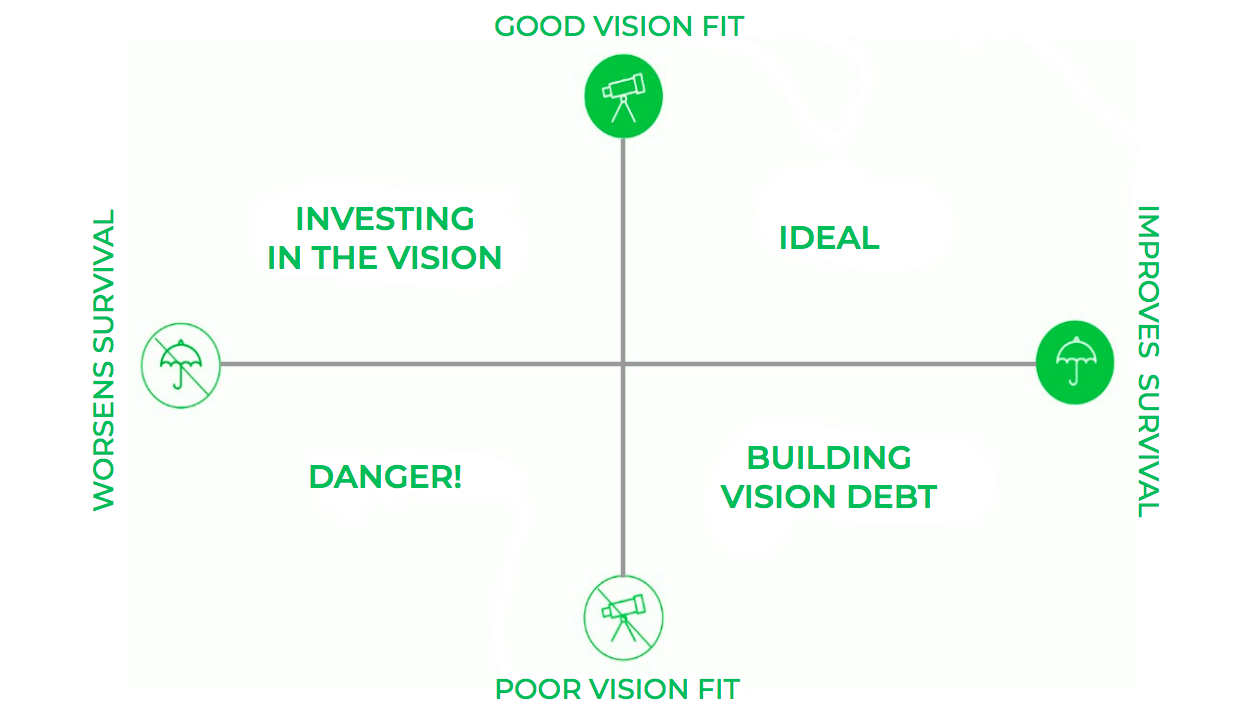Without a clear vision and strategy behind iterations, products become bloated, fragmented, directionless, and driven by irrelevant metrics.
This is when good products go bad - they catch product diseases. Here are the three most common product diseases, along with their most common symptoms and the preventive actions you can take:
1. Strategic Swelling:
Symptoms
Your product seems to do just about everything for everyone, and might even go fetch you a cup of coffee. When you’re not sure if a feature adds value to your business, your approach is to err on the side of including it rather than aggressively prioritizing. As a result, maybe you’re complicating your UX, or you’ve created several different pricing models to try to appeal to a wide range of customers. Your product is feels bloated.
Prevention:
There are two easy steps to preventing this product disease:
Step 1. Create a clear vision: A good vision gives you a North Star to evaluate strategic opportunities against. If your vision is too broad, the answer to whether you should add a feature or pursue an opportunity will always be yes! If you haven’t created a clear vision, start here. A detailed vision will make it easier to say No when appropriate.
Step 2. Translate your vision into priorities: As you make progress towards your vision, your investors may be pushing for more revenue-generating features while your customers demand other features urgently. Often Strategic Swelling arises when there’s a disconnect between the vision and everyday decision-making. Avoiding it requires balancing achieving your vision while managing the reality of your short-term business needs.
The simple Radical Product Thinking approach to prioritization helps you make the trade-offs that are right for your company and communicate your decision-making rationale to bring others on your journey with you. This 2x2 rubric helps you evaluate the right trade-offs:
 The Radical Product Thinking approach to prioritization
The Radical Product Thinking approach to prioritization
-
Ideal: These opportunities most closely match your vision while also helping you survive — this is obviously where you’d aim to spend most of your resources.
-
Investing in the Vision: These opportunities are a good vision fit, but aren’t helping your survival in the near term. These can be worthwhile to pursue, but not if you’re facing a cash crunch.
-
Building Vision Debt: Items in the bottom right corner are helping you survive, but are a poor fit for your vision; pursuing them incurs “vision debt” - too much of this will ultimately derail your product.
-
Danger!: Items in the bottom left are both a poor vision fit and are not likely to be profitable. Avoid pursuing anything here!
This format provides the basis for a constructive discussion to align the team on the product strategy and is a good way of evaluating new opportunities.
2. OSD (Obsessive Sales Disorder):
Symptoms
This disease happens when you continue to trade-off the vision in exchange for short-term gains - symptoms include taking on custom features to win sales opportunities or continually building features for customers who demand them (regardless of whether those features are extensible to other customers). Often the root cause of OSD is that being customer-driven is misunderstood to mean customer-led, i.e. give customers everything they ask for.
Prevention:
-
Recognize vision debt: There may be times when you have to take on custom integrations to win that one client and make your numbers. But, if you’re not keeping track of this so that you can get back to your vision as quickly as possible, you may keep adding to your vision debt. As you do too many of these, you start to look more like a professional services company than a product company.
-
Understand where the misalignment lies: In the examples above, if your sales person thinks an opportunity is good for your company but you disagree, either you differ on the vision or you both have different incentives. Understanding why you disagree will help you address the root cause of OSD rather than just managing symptoms.
3. Pivotitis:
Symptoms
Building products using the Lean Startup approach can be fast and exciting, but without a clear product vision, it becomes far too easy to solve problems by “pivoting” from one idea to the next. This often results in wild swings in your product offering and target customer segments, exhausting and confusing your team.
Prevention
-
Pivot less: This goes against popular advice — pivoting is often made to sound like it’s the key to entrepreneurial success. Slack’s “pivot” of going from a gaming company to a business chat product is held up as an example. In reality, you can pivot 2-3 times at most before you run out of money and momentum — every pivot needs to be treated with gravitas. If you think you need a pivot, start by revisiting your vision and align the team on how and why it needs changing.
-
Start fresh if you need to: Pivoting your HOW (i.e. your method for achieving your vision) is OK, but if your vision changes fundamentally, you don’t have a pivot on your hands — you have a whole new startup. Don’t be afraid to shed your connection to your past entirely if your vision doesn’t work out.
Radical Product Thinking helps you avoid these common product diseases so you can build world-changing products repeatably. If you’ve seen any of these diseases in your organization, share this article with your colleagues so you can start talking openly about the disease and create a plan to overcome it.
